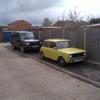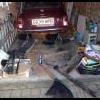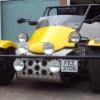
Acewell Gages
#1

Posted 28 December 2008 - 08:31 PM
i havent bought one but am thinking of getting an acewell and was wondering how easy they are to fit and how you connect it as the mini speedo ive got is mechanical and the acewell is digital??
YetI
#2

Posted 28 December 2008 - 08:51 PM
You dont use the mini speedo drive or cable, well you can, but it would be a bodge and would be just as much work as the magnetic speedo sensor.
#3

Posted 28 December 2008 - 11:03 PM
#4

Posted 28 December 2008 - 11:45 PM
when i bought my acewell i got an adaptor that screws directly onto the mini speedo cable... works faultlessly
as did i
#5

Posted 29 December 2008 - 10:47 AM
#6

Posted 29 December 2008 - 10:53 AM
when i bought my acewell i got an adaptor that screws directly onto the mini speedo cable... works faultlessly
as did imuch better than the magnetic sensor, and less prone to problems.
how so? its just a magnet going past a hall effect pick up? nearly every car on the road will have one, crank shaft sensor, or old style hall effect distributors
only unreliable part is if you havent connected it proppery or fastened it in place securly/with correct distances set which is 8mm if i remember correctly from doing mine
#7

Posted 29 December 2008 - 02:13 PM
http://www.theminifo...p;#entry1273699
As for the magnetic speed sensors, there are several types and not all perform to the same level. I don't know what ships with the Acewell so I can only offer comments on the "common" types.
Reed Switch: Cheap and common. This two-wire device is a mechanical switch that closes when a magnet passes nearby. They are limited in how fast they can open and close. They may not be suitable for high-speed driving. They can also be subject to false readings if the pickup (switch) is poorly mounted and vibrates.
Two-wire Inductive: Think of these like you would an ignition coil. A magnet passing by the pickup induces an electrical pulse, not a contact closure. They work well but often the sensor and magnet are large which makes them hard to install and they can affect the balance of rotating components. They also don't work well at low speeds. The magnet needs to go by the sensor fairly fast.
Hall-Effect: These are basically... electronic switches. These are three-wire devices and behave like a transistor. You have to supply them with power and earth. A third connection is for an output signal. Like transistors, the switch either provides a connection to the (+) voltage OR a connection to earth. You typically need to buy the right type of sensor to work with the gauge you're using. A lot of electronic instruments are "smart" enough to use either type. Hall-Effect sensors are very good at both high- and low-speed switching.
Inductive Proximity: Electrically these behave exactly like the Hall-Effect sensors mentioned above. They are three-wire devices that behave like transistor switches. However, unlike the Hall-Effect sensors, they are NOT looking for magnets to turn them on and off. An inductive proximity switch looks for "metal". Steel/iron is best as a target as it can be detected further away. Inductive proximity sensors are great for high speed switching. However, if you need one that can sense a target from fairly far away, the sensor required gets "bigger" pretty quickly.
My preference is for either the inductive proximity or Hall-Effect switches. These three wire sensors work great at both high- and low-speed. Industrial versions are typically sealed against moisture. The inductive proximity switch has the advantage that it can look for simple steel targets (like bolt heads) and no magnets are required.
#8

Posted 29 December 2008 - 05:44 PM
#9

Posted 30 December 2008 - 04:53 PM
Where you had problems with the reed switch before, you may benefit from moving it to a different location. In my case, I was able to mount the Sigma magnet on the inner (yoke type) driveshaft joint. A simple but stiff mounting bracket was bolted to the gearbox for the pickup. I have a couple of acquaintances who have taken a similar approach by thoroughly degreasing and bonding the magnet to the pot joint using epoxy.
#12

Posted 30 December 2008 - 08:07 PM
Alan..
#13

Posted 30 December 2008 - 11:36 PM
#14

Posted 31 December 2008 - 12:55 AM
You have to cut your speedo cable & fit it on the end of it, then attach the 3 wires
Alan..
Is that correct? The description made it sound like you cut the cable and inserted this in the middle. That would give you a digital pulse out to an electronic gauge while retaining the mechanical speedo drive. Did I read that incorrectly?
The concern I have is the fact as you say that this is a 3-wire device. Reed switches are often used with very low current instruments and as I mentioned earlier, it may require a dedicated interface circuit to allow the 3-wire sensor to connect to the 2-wire connection used by the Acewell speedometer. You can build such a circuit with a few simple components, but it's a bit of work if you're not comfortable with electronics.
Marky Tizz, to improve your existing reed switch performance consider mounting the speedo magnet on the pot joint as I suggested earlier. If that still doesn't address the problem, consider going to a firm that sells security systems. Ask them for a reed switch assembly and its matching magnet (often used on windows and doors as part of a security system). Tell them you want one that uses a powerful magnet... don't hesitate to tell them why. Replace the Acewell reed switch with the one from the security company, and use its matching magnet. If you mount the pickup/switch so vibration is minimized you should have good performance from it.
#15

Posted 31 December 2008 - 01:06 AM
Marky Tizz, to improve your existing reed switch performance consider mounting the speedo magnet on the pot joint as I suggested earlier. If that still doesn't address the problem, consider going to a firm that sells security systems. Ask them for a reed switch assembly and its matching magnet (often used on windows and doors as part of a security system). Tell them you want one that uses a powerful magnet... don't hesitate to tell them why. Replace the Acewell reed switch with the one from the security company, and use its matching magnet. If you mount the pickup/switch so vibration is minimized you should have good performance from it.
Great advice, thankyou very much. what do you mean by pot joint, however?
Mark
1 user(s) are reading this topic
0 members, 1 guests, 0 anonymous users




















